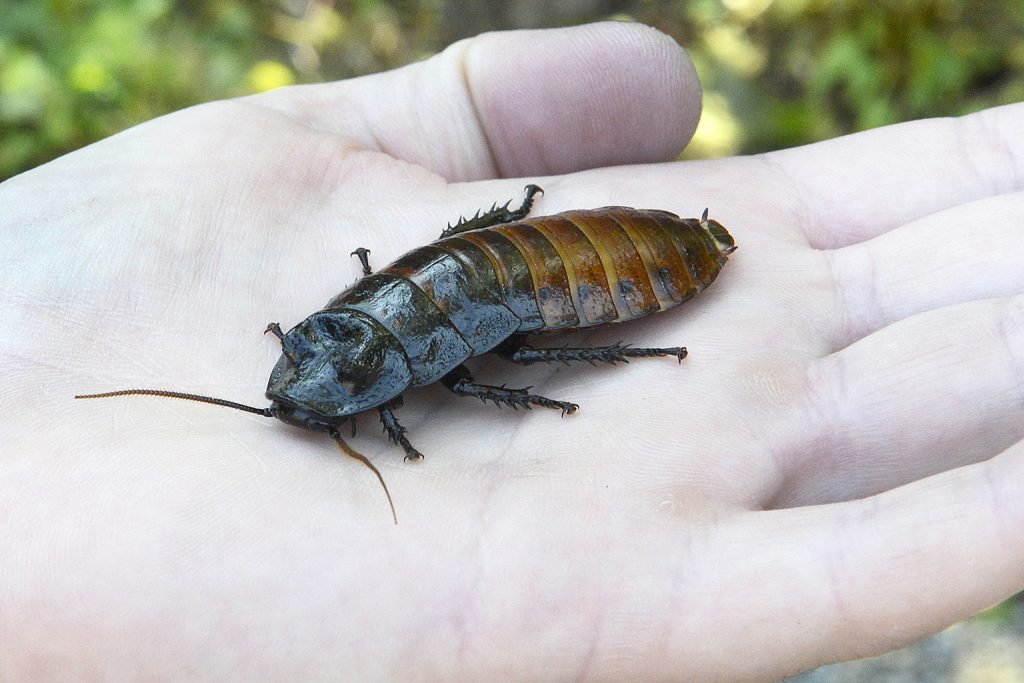Overview
“Where I live”
Madagascar hissing cockroaches live in the forests of Madagascar, an island nation off the coast of Africa.
At the Zoo, they are among the featured Animal Ambassadors introduced to audiences in education programs on and off grounds.
“How I live there”
Madagascar hissing cockroaches stay hidden beneath leaf litter or in rotting logs during the day and emerge at night to scavenge for food. These large bugs are detritivores, which means that they help break down decaying plant and animal matter – an essential role in any ecosystem. They feed mainly on fruit and other plant material.
Males are territorial and will defend their territory aggressively from other males. Females are not territorial.
“Making my mark”
Madagascar hissing cockroaches are one of the largest species of cockroach in the world. They are shiny brown and oval-shaped. They have no wings and a single pair of antennae. Males have large horns protruding from their heads.
These roaches are known for — and named for – the hissing sounds that they make. They hiss by expelling air through their breathing holes. They make four separate “hiss” calls: a male combat hiss, two mating and courtship hisses, and an alarm hiss that sounds like that of a snake.
“What eats me”
Madagascar hissing cockroaches try to scare off predators by hissing at them, but this certainly doesn’t work all the time. They are probably eaten by many animals, although these predator-prey relationships have not been well documented.
As they grow, young Madagascar hissing cockroaches molt – or shed their exoskeletons – approximately six times in six months. They are particularly vulnerable to predators during this short period of time because until their chitin hardens, they turn completely white, making them highly visible. They look like ghost roaches!
Raising Young
Males compete with each other for access to females. They ram each other with their horns and hiss at each other during battle. The roach that succeeds in flipping its opponent wins the contest, wins the female, and hisses loudest. After mating, females store their fertilized eggs in cocoon-shaped cases in their bodies and then, after about 60 days, give birth to dozens of live young. The baby cockroaches are independent from birth.
Conservation
Madagascar hissing cockroaches are listed as a species of least concern by the IUCN, the world’s leading conservation organization. The species is well established in Madagascar and has adapted fairly well to changes in habitat. Nonetheless, deforestation ranks as the most significant long-term threat to this and other forest-dwelling species in Madagascar.
Taxonomy
- Kingdom: Animalia
- Phylum: Chordata
- Subphylum: Vertebrata
- Class: Insecta
- Order: Blattodea
- Family: Giant cockroaches
- Genera: Gromphadorhina
- Species: portentosa
What is an Animal Ambassador?
The Maryland Zoo refers to its special collection of education program animals as “Animal Ambassadors.” The Zoo currently cares for more than 60 Animal Ambassadors, representing more than 40 species, both native and exotic. These animals are managed separately from the rest of the Zoo’s collection and cannot be seen on exhibit at the Zoo. However, many can be seen up close and personal on a rotating basis at Creature Encounters, the Zoo’s outdoor education center; at camp and school programs at the Zoo; as featured participants in community-based Outreach programs; and at special events on and off Zoo grounds.
Animal Ambassadors spend countless hours working with their human handlers, developing bonds of trust and communication that will allow them to appear in front of audiences large and small. They are not show animals. They behave naturally, focusing audiences’ attention on their natural behaviors and adaptations and giving living, breathing meaning to concepts and topics that students may be studying.
Animal Ambassadors travel all over the state of Maryland and beyond, and many also make local and national media appearances, educating about wildlife while representing the Zoo and its commitments to animal welfare and conservation.
What is The Animal Embassy?
The Animal Embassy at The Maryland Zoo is an off-exhibit area that is not open to the public. It is where the Zoo’s “Animal Ambassadors,” or education program animals, live. The Embassy is home to more than 60 individual animals representing more than 40 different species. It is staffed by its own dedicated group of keepers and volunteers and has both indoor and outdoor living space for the animals.


